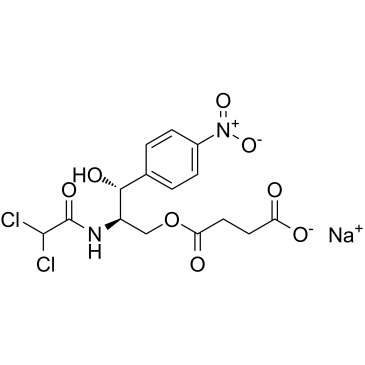琥珀酸钠氯霉素

琥珀酸钠氯霉素结构式

|
常用名 | 琥珀酸钠氯霉素 | 英文名 | Chloramphenicol sodium succinate |
|---|---|---|---|---|
| CAS号 | 982-57-0 | 分子量 | 445.184 | |
| 密度 | N/A | 沸点 | 716.3ºC at 760mmHg | |
| 分子式 | C15H15Cl2N2NaO8 | 熔点 | N/A | |
| MSDS | 中文版 美版 | 闪点 | 387ºC | |
| 符号 |

GHS08 |
信号词 | Warning |
琥珀酸钠氯霉素用途Chloramphenicol succinate sodium 是 Chloramphenicol 的前药,具有血液学毒性。Chloramphenicol succinate sodium 是琥珀酸脱氢酶 (SDH) 的竞争底物和抑制剂,可能是其产生毒性的原因。 |
| 中文名 | 琥珀酸钠氯霉素 |
|---|---|
| 英文名 | Chloramphenicol sodium succinate |
| 中文别名 | 4-[2-[(2,2-二氯乙酰)氨基]-3-羟基-3-(4-硝基苯基)丙氧基]-4-氧代丁酸钠 |
| 英文别名 | 更多 |
| 描述 | Chloramphenicol succinate sodium 是 Chloramphenicol 的前药,具有血液学毒性。Chloramphenicol succinate sodium 是琥珀酸脱氢酶 (SDH) 的竞争底物和抑制剂,可能是其产生毒性的原因。 |
|---|---|
| 相关类别 | |
| 参考文献 |
| 沸点 | 716.3ºC at 760mmHg |
|---|---|
| 分子式 | C15H15Cl2N2NaO8 |
| 分子量 | 445.184 |
| 闪点 | 387ºC |
| 精确质量 | 444.010315 |
| PSA | 161.58000 |
| LogP | 0.90410 |
| 外观性状 | 白色粉末 |
| 储存条件 | 库房低温通风干燥 |
| 符号 |

GHS08 |
|---|---|
| 信号词 | Warning |
| 危害声明 | H351 |
| 警示性声明 | P280 |
| 个人防护装备 | Eyeshields;full-face particle respirator type N100 (US);Gloves;respirator cartridge type N100 (US);type P1 (EN143) respirator filter;type P3 (EN 143) respirator cartridges |
| 危害码 (欧洲) | Xn: Harmful; |
| 风险声明 (欧洲) | R40 |
| 安全声明 (欧洲) | 22-36 |
| 危险品运输编码 | NONH for all modes of transport |
| WGK德国 | 3 |
| RTECS号 | AB6905000 |
|
The myelotoxicity of chloramphenicol: in vitro and in vivo studies: II: In vivo myelotoxicity in the B6C3F1 mouse.
Hum. Exp. Toxicol. 17(1) , 8-17, (1998) 1. Chloramphenicol continues to be widely used in many parts of the world despite its known haematotoxicity. Until now, elucidation of the mechanisms involved and any attempt at amelioration of the to... |
|
|
A commercial enzyme immunoassay method (EMIT) compared with liquid chromatography and bioassay methods for measurement of chloramphenicol.
Clin. Chem. 34(9) , 1872-5, (1988) A new enzyme immunoassay method (EMIT; Syva Co.) was compared with conventional high-performance liquid chromatography (HPLC) and agar-diffusion bioassay methods for measurement of chloramphenicol in ... |
|
|
Chloramphenicol succinate, a competitive substrate and inhibitor of succinate dehydrogenase: possible reason for its toxicity.
Toxicol. In Vitro 18(4) , 441-7, (2004) From our previous study [Eur. J. Clin. Pharmacol. 56 (2000) 405] we hypothesized that chloramphenicol succinate (CAPS) may be a competitive substrate for succinate dehydrogenase (SDH). It may be oxidi... |
| (R-(R*,R*))(-)-Butanedioic Acid Mono(2-((2,2-dichloroacetyl)amino)-3-hydroxy-3-(4-nitrophenyl)propyl) Ester Monosodium Salt |
| Globenicol |
| Chloramphenicol succinate sodium |
| Nevimycin |
| Clorofenicina |
| Solnicol |
| 2,2-Dichloro-N-(b-hydroxy-a-(hydroxymethyl)-p-nitrophenethyl)acetamide a-Ester with Sodium Succinate |
| Chloramphenicol monosuccinate sodium salt |
| protophenicol |
| Betamicetin |
| Nalecin |
| EINECS 213-568-1 |
| MFCD00083598 |
| Levomycetin-Nalcein |
| D-threo-(-)-2,2-Dichloro-N-(b-hydroxy-a-(hydroxymethyl)-p-nitrophenethyl)acetamide a-(Sodium Succinate) |
| Cloromoin |
| butanedioic acid, mono[(2R,3R)-2-[(dichloroacetyl)amino]-3-hydroxy-3-(4-nitrophenyl)propyl] ester, monosodium salt |
| CHLORAMPHENICOL,NASUCCINATE |
| Butanedioic acid, mono[(2R,3R)-2-[(2,2-dichloroacetyl)amino]-3-hydroxy-3-(4-nitrophenyl)propyl] ester, sodium salt (1:1) |
| Chloramphenicol sodium succinate |
| Sodium 4-{[(2R,3R)-2-[(dichloroacetyl)amino]-3-hydroxy-3-(4-nitrophenyl)propyl]oxy}-4-oxobutanoate |
| Mychel-S |
| Sodium chloramphenicol succinate |


